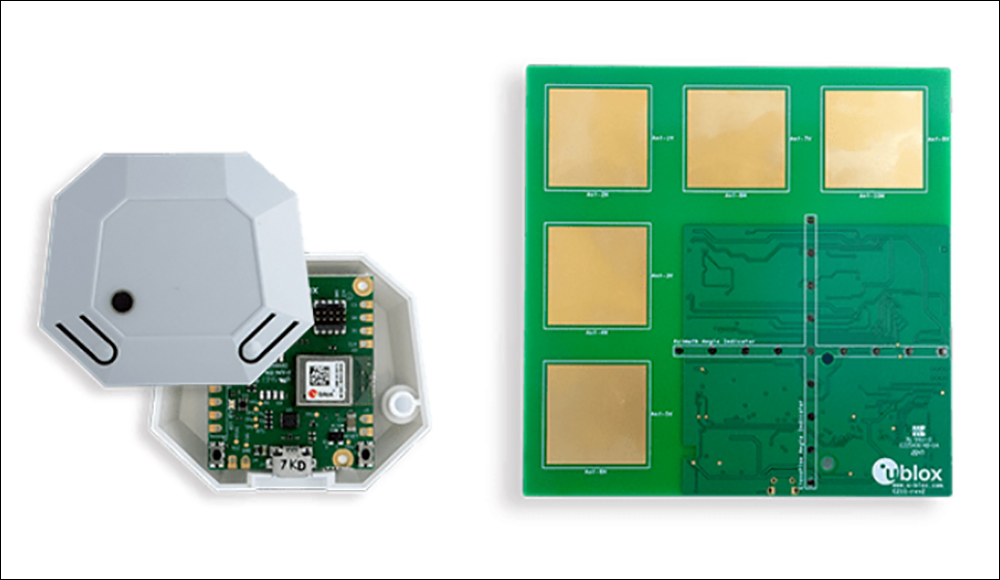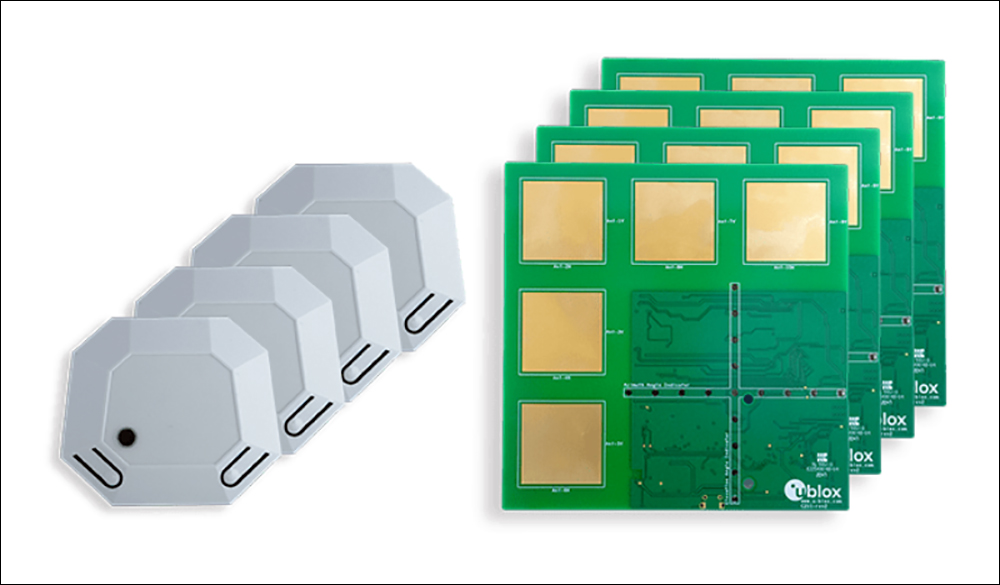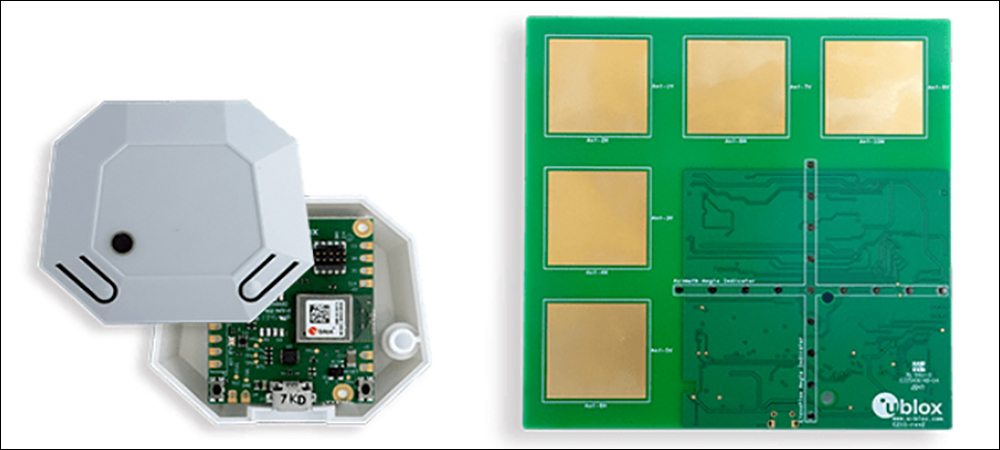Leveraging Bluetooth Low Energy (BLE) 5.1 for angle-of-arrival (AoA) functionality, along with its own software algorithms, Swiss technology firm u-blox is offering developer kits for precise indoor positioning solutions. The company’s XPLR-AOA-1 and XPLR-AOA-2 “explorer kits” are intended to enable the testing of BLE’s location capabilities for such applications as access control, collision detection, indoor positioning and asset tracking. U-blox says the kits were designed to help users build systems with low power consumption that are simple to deploy and low in cost.
The wireless semiconductor company provides positioning technology for the automotive and industrial markets. Launched in 1997, u-blox began by offering what is known as Global Navigation Satellite Systems (GNSS). These days, the company is a leader in GNSS for navigation, according to Pelle Svensson, a u-blox senior principal. Its products are in use in the majority of vehicles built worldwide.

The XPLR-AOA-1 kit
In 2014, u-blox acquired Swedish short-range radio module company connectBlue to add Wi-Fi and Bluetooth technologies to its portfolio. Since then, says Svensson, who originated at connectBlue, “We’ve taken that knowledge also into the BLE domain, for indoor use cases.
Bluetooth 5.1, released in 2019, provides direction-finding features that make it possible to determine the direction in which radio signals travel from a mobile tag to one or more fixed anchor points (see BLE Standard Brings RTLS Functionality to Beacons). Using AoA and angle-of-departure (AoD) technologies, anchor points comprising an antenna array connected to a Bluetooth receiver can detect the direction, or angle, of a mobile tag that transmits the Bluetooth signal. When a constellation of such multi-antenna anchors is deployed, the BLE 5.1 technology can be used to triangulate the precise location of a mobile device or tag.
Companies are now building solutions that leverage this technology for indoor location, and u-blox hopes to make that process easier with its explorer kits. The XPLR-AOA-1 kit includes a Bluetooth 5.1 C211 antenna board and a C209 tag, as well as with the company’s u-connectLocate software, which can accomplish angle calculation within two or three dimensions. An LED enables users to view the AoA response. The kit is being used for applications such as access control.

The XPLR-AOA-2 kit
The XPLR-AOA-2 explorer kit offers four tags and four antenna boards, along with the software and direction-finding algorithm. Positioning engine software enables the triangulation of the tag’s position. In that way, it can be used for more granular positioning for such use cases as asset tracking or collision prevention, since users know exactly where a moving tag is located in real time.
Both explorer kits employ u-blox’s NINA-B4 Bluetooth 5.1 low-energy module, featuring Nordic Semiconductor‘s nRF52833 BLE system-on-chip (SoC). Running on the SoC’s embedded MCU, the u-connectLocate software calculates the angles of the incoming signals, with no additional processing required. Both kits offer location accuracy of less than a meter for indoor environments. Applications include detecting whether a person or object is approaching a door, avoiding collisions between moving objects, and directing a camera at a moving tag.
In addition, u-blox is partnering with Traxmate on an enterprise asset-tracking platform that enables developers to set up the tracking environment for their application, including creating buildings, uploading floor plans and specifying the placements of anchor points. Developers can also use the kit to track the locations of assets in real time via the Web or on a dedicated smartphone app.

Pelle Svensson
Companies have been developing BLE 5.1-based solutions since the specification was released. Traditionally, BLE technology can be utilized for indoor positioning using received signal strength indicators (RSSI), which enable systems to identify location based on signal strength received from a tag. In that way, the technology can determine the general location. Bluetooth 5.1 provides constant tone extension (CTE), allowing antennas to detect the phased difference in received radio signals and thereby calculate the angle.
U-blox built its own software into the system for the two kits. “What we have done is provide 5.1 functionality in the tag and receiver,” Svensson explains, “along with quite sophisticated algorithms.” Those algorithms, included in the positioning engine software, can accomplish multipath compensation to filter out signals that are merely reflections. Without this feature, the location data would be less accurate, he notes, since reflection transmissions can impact results and skew data. “If you take too much reflection in the calculations, you will get bad accuracy. We spent a lot of energy testing different algorithm types and made the decision to make a solution ourselves.” The company also built machine-learning functionality into the solution.
Applications for which developers are using the kits include a more intelligent access-control system. The BLE 5.1-based technology can enable software to identify such information as whether a forklift is passing or approaching a locked door. Only if a tagged forklift were to approach the door would the receiver identify that the vehicle was attempting to enter, based on the transmission angle. The system would confirm the tag’s ID number to determine whether that vehicle was authorized to enter, and it could then prompt the door to open. If the forklift was simply passing the door, however, the authorization and opening features would not be activated.
Another use case is the development of systems for tracking the movements of an individual for a “follow me” application. In this scenario, an air purifier or lighting system, for instance, could be turned on based on a person’s precise location. The kits are also being utilized for logistics and manufacturing, as well as by hospitals, to identify the room in which specific equipment is located. Some companies are building the technology into smart door locks for residential purposes, using AoA to understand if an individual is inside or outside a door, and whether they are passing or approaching.
“We are the first [company] with a kit that has transmitter, receiver, antennas and software,” Svensson states. Since BLE 5.1 was released, the firm has been working on the kits and optimizing the algorithms and its positioning engine to operate either on premise or in the cloud. The solution has been tested internally in a room measuring 8 meters by 6 meters (26 feet by 20 feet) with four anchors, one in each corner, and it can accomplish approximately 2 feet of positioning accuracy.
A large warehouse would use a greater number of receivers, typically one for every 40 feet, to accomplish that same level of accuracy. That could provide real-time location information regardong assets tagged with BLE tags, and route automation could help to determine how best to optimize the facility. The kit is available through u-blox’s sales channels, and those who use it can purchase a full solution. “We are developing products we can deliver in high quantities,” Svensson says, which users could deploy permanently.
Bluetooth 5.1 is also capable of AoD functionality, by which the BLE tag would detect the angle of transmissions from the anchor. Such a feature could be used with smartphones once handset manufacturers build the technology into their devices. The phones could then detect their own location for wayfinding or indoor navigation systems. With AoA, on the other hand, the system requires an app to display the angle data being captured by the anchor, rather than the phone, which is a slower process.
There are other technologies that provide indoor positioning, such as UWB and Wi-Fi, though such systems tend to be more power-hungry, Svensson says. Prices for BLE are lower, he adds, and there is a large community working with BLE, comprising around 30,000 different companies. The XPLR-AOA-1 kit is available now, priced at a few hundred dollars, while XPLR-AOA-2 is slated to be released in August 2021.
With the kits, Svensson reports, “We want our potential customers—device manufacturers, solution providers—to explore what BLE can do in this respect, to explore how accurate can the location information be.” Users can bring specific requests for customized solutions to u-blox, he says, adding, “Now we’re coming to the point that [BLE 5.1] can be used in commercially available solutions.”


